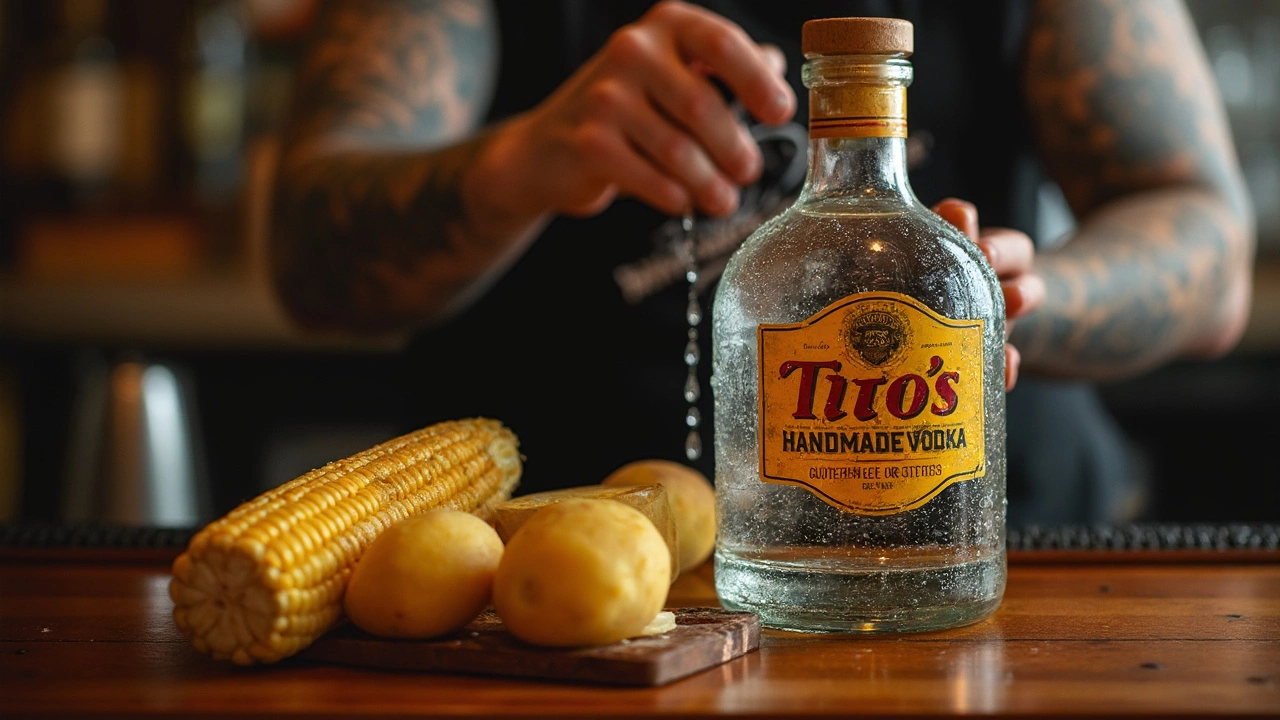If you’ve ever stood in the vodka aisle and wondered why Tito’s seems to have its own following, you're not alone. For a lot of folks, this isn’t just another clear bottle—it’s the go-to choice for everything from classic martinis to quick-and-easy mixers.
But what seriously sets Tito’s apart? It’s not a fancy label or a slick ad campaign. Most people notice right away that Tito’s isn’t your typical wheat or potato vodka. Nope, they run with corn as the base. And if you have any buddies with gluten issues, you’ve probably heard them praise Tito’s for being gluten-free. That’s actually true, not just some trend on the label.
Another thing: Tito’s puts a lot of weight on their production style. Instead of big, automated machines churning it out, they use old-school pot stills—think handmade, batch by batch, almost like how some whiskies are made. It’s kind of rare in the mass vodka game. So, does this stuff taste different because of that? You bet. There’s a softness—almost sweet, but not sugary—that you don’t get in most other vodkas.
How Tito's Vodka Is Made
If you've ever dug around looking for what makes Tito's vodka different, it all starts with their process. Unlike most big vodka brands that use wheat, rye, or potatoes, Tito’s goes all-in on corn—yellow #2 dent corn, to be exact. That means every bottle starts out with an American-grown grain that's cheap and great at turning into alcohol.
The next thing to know: Tito’s skips the giant industrial stills you’ll find at most factories. They use old-school copper pot stills, similar to what small whiskey distillers use. It’s a slower method, but the idea is to get better control over the spirit. Instead of making one big batch after another, it’s all about small, consistent runs.
Here’s a nutshell version of how it happens:
- They mash and ferment corn. The corn gets ground up, cooked, and turned into a sugary mash. Yeast chows down on the sugar and spits out alcohol.
- The “wine” gets distilled six times. Every run strips out more junk, leaving just the clean, smooth spirit people expect from Tito’s.
- After distilling, the vodka gets filtered a few more times to nix anything harsh.
- Finally, it’s cut with water and bottled by hand at their Austin, Texas distillery.
One thing to note: There are no added flavors or sweeteners—just pure, unflavored vodka. That’s by design, because Tito’s wants the spirit to taste clean and easy to mix.
| Step | Description |
|---|---|
| 1. Mashing & Fermentation | Corn is mashed and fermented to create alcohol. |
| 2. Distillation | Distilled in copper pot stills up to six times. |
| 3. Filtration | Filtered for extra purity and smoothness. |
| 4. Bottling | Cut with water, then bottled by hand. |
This hands-on approach is rare for a brand as big as Tito's vodka. That's a big part of why a lot of folks give it repeat business—there’s care in every bottle, not just another run off the assembly line.
Why Corn Matters
When you’re talking about Tito's vodka, the corn part isn’t just a random choice—it plays a big role in how the vodka turns out. Most classic vodkas use wheat, rye, or potatoes, but Tito’s does it different with 100% corn. The founder, Tito Beveridge, picked corn because it was cheaper and more local in Texas, but as it turns out, it gives the vodka a unique taste and feel.
Corn-based vodka tends to come out a bit sweeter and smoother. That doesn’t mean sugary—just less harsh compared to some grain vodkas. This is a bonus for people who aren’t big fans of the usual burn you get with some other brands. If you want something that mixes easily but doesn’t disappear in a cocktail, this makes Tito’s a pretty solid choice for your home bar.
Here’s a quick look at how corn compares to the usual vodka bases:
| Vodka Base | Common Flavor Notes | Main Countries |
|---|---|---|
| Corn | Smooth, slightly sweet, less burn | USA |
| Wheat | Crisp, clean, neutral | Russia, France, Sweden |
| Potato | Earthy, creamy, fuller body | Poland, Russia |
| Rye | Spicy, bold, dry | Poland, Russia |
Another upside? Corn is naturally gluten-free. So even before the distilling process strips most vodka of gluten, Tito’s can confidently advertise to health-conscious drinkers and folks who deal with celiac or gluten sensitivity. They even get their gluten-free vodka certified, which matters if you’re looking for peace of mind when you pour yourself a drink.
So, the corn isn’t just great marketing. It helps make Tito’s stand out in taste, mixability, and for anyone who pays attention to what’s in—and not in—their glass.

What Gluten-Free Really Means
If you hear "gluten-free vodka" and think marketing stunt, you're not alone. But with Tito's vodka, it actually means something, and people who need to stay away from gluten will notice the difference. Most vodkas start as grain (like wheat, rye, or barley), and those naturally have gluten. Tito's starts with 100% corn, which never contains gluten in the first place.
Here’s what matters: all vodka is technically supposed to be distilled enough that any gluten protein gets removed. But studies and the U.S. government say those with celiac or serious gluten issues should stick with spirits made from something like corn or potatoes, just to be safe. That’s why Tito’s gets its “gluten-free” label, and it’s even certified by the Gluten Intolerance Group (GIG).
Just to clear up confusion, here’s what makes Tito's vodka different from regular grain vodkas:
- Corn Base: No gluten at any stage. Ever.
- No Cross-Contamination: The distillery keeps everything separate, so people with gluten allergy don’t have to worry about trace amounts.
- Official Certification: It’s gotten the stamp of approval from legit gluten-free groups.
| Vodka Brand | Main Ingredient | Gluten-Free Certified? |
|---|---|---|
| Tito's | Corn | Yes |
| Grey Goose | Wheat | No |
| Smirnoff | Corn | Yes |
| Absolut | Wheat | No |
Bottom line: If you or someone you care about has a gluten allergy or celiac, you can reach for Tito’s without second-guessing it. It’s an easy choice that tastes good in pretty much any mix, and you don’t have to worry about next-day regret from hidden gluten.
Best Ways to Drink Tito's
People love Tito's vodka because it's easy to drink, mild, and doesn’t have the burn you get with some other vodkas. The smooth finish means you can use it for almost anything, but some ways just work a little better.
- Classic Vodka Soda: Grab some ice, pour two ounces of Tito’s, and top it off with soda water. Squeeze in a lime and you’ve got a light, refreshing drink that actually lets Tito’s subtle sweetness come through.
- Moscow Mule: Tito’s shines in a Moscow Mule. All you need is ginger beer, fresh lime, and plenty of ice. Serve it in a copper mug for bonus style points.
- Dirty Martini: If you like savory drinks, this is for you. Use Tito’s, a little olive brine, and some dry vermouth. You’ll notice it’s less harsh than typical martini vodkas, which is great if you want to actually taste your drink.
- Lemonade Punch: Mix Tito’s with lemonade and a splash of cranberry for something simple that works at house parties. The corn base gives it a mellow touch that plays well with sweet or tart flavors.
Here’s what John McCarthy, a spirits expert and writer for Forbes, says about Tito's vodka:
“Tito’s has a round, almost creamy body and a clean finish, which makes it a great mixer but surprisingly sippable neat or on the rocks, too.”
If you’re not into straight vodka, no worries. Tito’s is made for mixing, and bartenders often choose it because it won’t overpower other flavors. At some bars, up to 40% of vodka cocktails feature Tito’s—it’s that popular.
| Popular Tito's Drink | Main Mixers | Prep Time (min) |
|---|---|---|
| Vodka Soda | Soda Water, Lime | 2 |
| Moscow Mule | Ginger Beer, Lime | 3 |
| Dirty Martini | Vermouth, Olive Brine | 4 |
| Lemonade Punch | Lemonade, Cranberry Juice | 3 |
One last tip: Tito’s has a soft sweetness thanks to the corn, so if you drink it straight or on the rocks, you’ll pick it up more than when you add strong mixers. Want something easy but different? Mix Tito’s, tonic, and a slice of grapefruit. It’s fresh, fast, and a crowd-pleaser.


